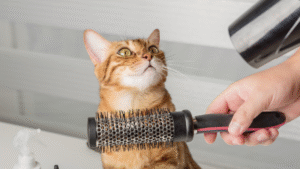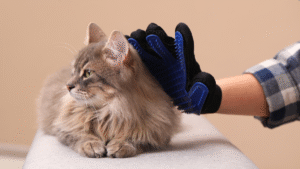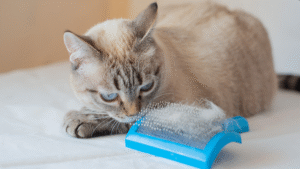Regular grooming and brushing keep your feline friend clean, beautiful, and comfortable. Brushing also helps prevent painful matting, excessive shedding, hairballs, and dry or irritated skin. Proper brushing distributes natural oils and brings out the healthy shine in your cat’s fur.
Brushing can also be a wonderful bonding activity and a key way to build trust with your cat. But when faced with dozens of brushes at the pet store, which one is right for your cat? The good news is that you don’t need every type of brush to properly groom your cat—the best choice will largely depend on your cat’s fur type.

Cat Coat Types
Before purchasing a brush, it’s important to understand the type of fur your cat has. Most cats fall into one of three main categories:
Short-Haired Cats
Cats such as American Shorthairs, Siamese, and Burmese have short, sleek coats that lie close to their skin. While they’re the easiest to maintain, short-haired cats still benefit from regular brushing to remove loose hair and keep their coat shiny.
Medium-Haired Cats
Breeds like British Shorthairs, Manx, and Bengals have slightly longer coats that can trap loose fur and develop tangles or small mats if not brushed regularly.
Long-Haired Cats
Long-haired cats such as Persians, Maine Coons, and Ragdolls have thick, luxurious coats that can easily tangle or mat without consistent brushing and care.

Best Cat Brushes for Short-Haired Cats
Short-haired cats may not shed or tangle as much as their long-haired counterparts, but they still benefit from regular brushing to remove loose fur, dirt, and dander.
1. Rubber Grooming Brush
Rubber grooming brushes are an excellent choice for short-haired cats. The Kong ZoomGroom, for example, features soft rubber bristles that attract loose hair while gently massaging your cat’s skin. It’s also great for sensitive cats and can even be used during bath time for a shampoo-free massage.
Why it’s the best: Gentle on the skin, doubles as a massager, and easy to use while bathing.
Best for: Nervous or sensitive cats.
2. Bristle Brush
A bristle brush features tightly packed bristles that help smooth your cat’s coat and collect loose fur. It’s particularly useful for maintaining a shiny, polished finish.
Why it’s the best: Distributes natural oils, smooths the coat, and enhances shine.
Best for: Cats with sleek, low-shedding coats.
3. Grooming Glove
If your cat dislikes traditional brushes, a grooming glove may be your new best friend. Simply wear the glove and pet your cat as usual—the glove’s textured surface will catch loose fur with every stroke.
Why it’s the best: Ideal for cats that dislike brushes and doubles as a bonding activity.
Best for: Brush-resistant or anxious cats.

Best Cat Brushes for Medium-Haired Cats
Medium-haired cats fall right in the middle of the grooming spectrum. They need tools that can both remove loose fur and prevent minor tangles.
1. Slicker Brush
A slicker brush is one of the most popular and effective grooming tools. It features fine, bent wire bristles that glide through your cat’s coat to lift loose hair and prevent matting.
Why it’s the best: Removes loose fur and prevents undercoat matting.
Best for: Cats with thicker or double-layered coats.

2. Dual-Sided Brush
Dual-sided brushes offer two grooming options in one: the wire pin side is perfect for detangling, while the bristle side smooths and polishes the coat. This versatile brush is ideal for medium-haired cats that need both detangling and finishing touches.
Why it’s the best: Convenient, versatile, and helps reduce shedding while adding shine.
Best for: Cats that shed moderately or have uneven coat thickness.
3. De-shedding Tool
De-shedding tools, like the FURminator, are designed to remove dead undercoat hair without damaging the topcoat. They significantly reduce shedding and help minimize hairballs.
Why it’s the best: Reduces shedding and prevents matting.
Best for: Medium-haired cats that shed heavily or have dense coats.
Best Cat Brushes for Long-Haired Cats
Long-haired cats require the most grooming care. Their beautiful coats can quickly become tangled or matted without daily attention.
1. Wide-Tooth Comb
A wide-tooth comb is a must-have for long-haired cats. It allows you to gently detangle fur without pulling, especially around sensitive areas like the belly, chest, and legs.
Why it’s the best: Helps prevent painful mats and tangles.
Best for: Cats with long, thick coats such as Persians or Ragdolls.
2. Long-Pin Slicker Brush
A long-pin slicker brush differs from a regular slicker brush because its extended pins reach deep into dense fur to remove loose hair, tangles, and debris.
Why it’s the best: Reaches deep into thick coats to remove loose undercoat and dirt.
Best for: Cats with dense, double-layered coats.
3. Dematting Comb or Rake
Dematting combs and rakes are designed specifically for removing stubborn mats and heavy undercoats in long-haired cats. They feature curved, sharp blades that safely cut through tangles without pulling.
Why it’s the best: Effective for removing tough mats and thick undercoat.
Best for: Cats that mat easily, such as Maine Coons or Himalayans.

Bonus: Extra Tools and Grooming Accessories
To achieve professional-quality grooming at home, consider adding these extra tools to your kit:
-
Lint roller or grooming wipes: Great for quick touch-ups and removing fur from furniture.
-
Detangling spray: Makes brushing smoother, especially for long-haired cats.
-
Grooming scissors: Useful for trimming mats in delicate or hard-to-reach areas.
-
Undercoat rake: Ideal for cats with thick undercoats or during heavy shedding seasons.
FAQs About Cat Brushes
How often should you brush your cat?
Brushing frequency depends on your cat’s coat type.
-
Short-haired cats: Once or twice a week
-
Medium-haired cats: Two to three times a week
-
Long-haired cats: Daily or every other day
In addition to keeping the coat shiny and tangle-free, regular brushing helps you spot fleas, skin issues, or injuries early.
How do you brush a cat the right way?
Start slowly with short sessions to help your cat get used to grooming. Brush in the direction of fur growth using gentle pressure to avoid pulling. Focus on problem areas—behind the ears, under the legs, and along the belly—where mats are more likely to form. Keep sessions calm and positive, and avoid brushing when your cat is stressed.

What are the benefits of brushing your cat?
Brushing offers several long-term benefits beyond a beautiful coat:
-
Reduces shedding and hairballs
-
Improves skin health by stimulating oil production
-
Strengthens your bond with your cat
-
Helps detect health issues early
The Bottom Line
The best brush for your cat depends on their coat type.
-
Short-haired cats: Rubber or bristle brushes
-
Medium-haired cats: Slicker or dual-sided brushes
-
Long-haired cats: Wide-tooth combs, long-pin slicker brushes, or dematting tools
Choosing the right brush and maintaining a regular grooming routine will keep your cat healthy, happy, and looking their absolute best.
- Homemade Calming Spray To Help Dogs During Training - November 12, 2025
- 7 DIY Dog Training Tools You Can Make From Household Items - November 12, 2025
- How To Make Your Own Clicker For Dog Training - November 12, 2025
